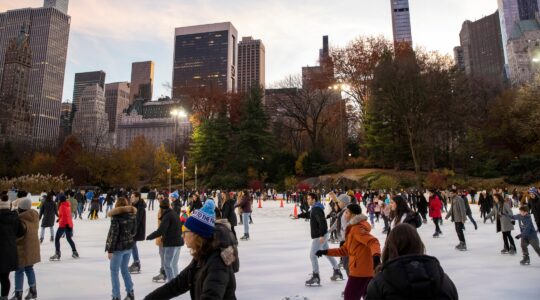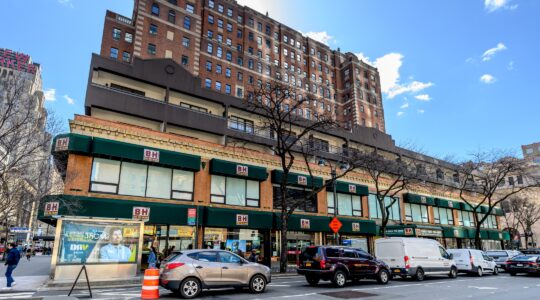When the midwinter chill sets in, New York Jews head to Florida; British Jews head to Lanzarote, the most spectacular of Spain’s Canary Islands.
In terms of climate, Lanzarote is actually more Los Angeles than Florida — dry and sunny, with winter afternoons that hover around 70 while mainland Spain shivers. But Lanzarote is more than a warm-weather getaway. It is a dramatic, largely treeless sweep of volcanic mountains, arid craters and black-sand beaches — an otherworldly landscape that is a change of scene from pretty much anywhere else.
The big cities and established Jewish communities lie on the larger, more developed Canary islands of Tenerife and Gran Canaria. Lanzarote, by contrast, is favored precisely for its remove; it’s an outpost of Spain that, despite the palm trees and luxury hotels, feels nothing at all like the mainland’s popular tourist destinations in Costa del Sol.
Hot, arid winds sweep across Lanzarote’s wide expanses of sand and sun-baked lava — a reminder that Lanzarote, like its Canary sisters, is far closer to Africa than to Europe. The smallish island lies just off the southwest coast of Morocco, an easy flight connection from Western European hubs. (Paying the bill will also be easier this winter, thanks to the tanking euro, which at press time was hovering around $1.20 — down about 25 percent from a few years ago).
Despite its popularity among British holidaymakers, Lanzarote still feels remote and unspoiled. Its rocky coasts are dotted with low-slung, whitewashed pueblos instead of high-rise resorts, and large swaths of the island are parks and nature preserves.
Nature itself destroyed as much as it preserved of Lanzarote. Settled in classical times, Lanzarote was crisscrossed in the succeeding eras by Moors, Mediterranean pirates, colonial slave traders, the French and, of course, the Spanish. Here and there, amid the quiet alleys of Arrecife on the southern coast, you can still see churches and forts from turbulent epochs.
Then in the 18th and early 19th centuries, what may be the most violent series of volcanic eruptions in modern history put Lanzarote on the map once again. Nearly a third of the island was coated with melting rivers of thick black lava, transforming a jungly paradise into the austere, barren moonscape that captivates today.
While many come to Lanzarote just to sprawl, lizard-like, on miles of sandy beaches, outdoors enthusiasts relish exploring the exotic interior. Windsurfers flock to the Atlantic waves; cyclists and hikers roam paths through the volcanic ruins, savoring vistas of sea between dune and peak.
The less-rugged among us can catch a bus tour through still-steaming lava fields, along centuries-old craters and over wave-battered cliffs at Timanfaya National Park, on the island’s west coast. The more adventurous can sign on for a tour across the dunes by camel.
Tucked into one particularly scenic cove here is El Golfo, a tiny, whitewashed pueblo (virtually all of Lanzarote’s buildings are a blinding shade of white, a stark contrast against the ashen mountains). El Golfo’s appeal lies in its setting — a limpid green lagoon surrounded by jagged black and red clay cliffs, which you can contemplate from a wooden-barrel bar stool if the weather isn’t warm enough for sunbathing.
Try a glass of local wine from Geria — a central winemaking region where neat circles of grape vines flourish, improbably, amid the sandy black soil. White varietals predominate, with an emphasis on semi-sweet and muscatel wines that pair well with the island’s fresh fish and vegetables (indeed, compared to the pork-and-shellfish-heavy mainland, vegetarians have a far easier time on Lanzarote).
Many of Lanzarote’s manmade attractions are creative adaptations of the natural setting. All along the coastline, bathers lounge in natural pools that fill ocean craters; many island dwellings appropriate this volcanic detritus to architectural effect.
Thousand-year-old subterranean lava tubes have been turned into shimmering grottos, as at Cueva de los Verdes and Jameos del Agua at the island’s northern tip, which occupy two caverns within the same nature preserve. These surreally beautiful caves — which served as hideouts during pirate raids — have been developed into cultural centers, with concert halls and exhibition spaces carved into the poolside rock.
Not all of Lanzarote is twisted and charred. Some of the more popular beaches, like the southern resort at Playa Papagayo, boast white sand alongside sparkling turquoise waters. Papagayo is Lanzarote at its most docile. But as the shadow of those black volcanoes reminds you, here in the Canaries, the wild unpredictability of nature is always present.
The New York Jewish Week brings you the stories behind the headlines, keeping you connected to Jewish life in New York. Help sustain the reporting you trust by donating today.




